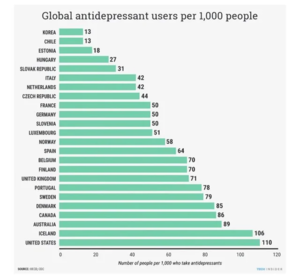Antidepressants
From BurnZero
Antidepressant are molecules which reduce depressive symptoms in humans. Antidepressants are thought to work by modulating the levels of neurotransmitters in the brain, which can help improve mood, reduce feelings of sadness or emptiness, and restore a sense of well-being.
There are several classes of antidepressants, each with its own mechanism of action. Some common types include:
- Selective serotonin reuptake inhibitors (SSRIs): These medications, such as fluoxetine (Prozac), sertraline (Zoloft), and escitalopram (Lexapro), primarily increase the levels of serotonin in the brain. Serotonin is associated with mood regulation.
- Serotonin-norepinephrine reuptake inhibitors (SNRIs): Medications like venlafaxine (Effexor) and duloxetine (Cymbalta) increase the levels of both serotonin and norepinephrine, another neurotransmitter involved in mood regulation.
- Tricyclic antidepressants (TCAs): Older antidepressants like amitriptyline (Elavil) and imipramine (Tofranil) increase the levels of serotonin and norepinephrine. They are generally used when other medications have not been effective.
- Monoamine oxidase inhibitors (MAOIs): These medications, such as phenelzine (Nardil) and tranylcypromine (Parnate), work by inhibiting the enzyme monoamine oxidase, which breaks down serotonin, norepinephrine, and dopamine. MAOIs are usually prescribed when other antidepressants have not worked or when there is an atypical response to other medications.
- Atypical antidepressants: This category includes various medications that don't fit into the other classes, such as bupropion (Wellbutrin), which primarily affects dopamine and norepinephrine, and mirtazapine (Remeron), which affects serotonin and norepinephrine in a different way.
